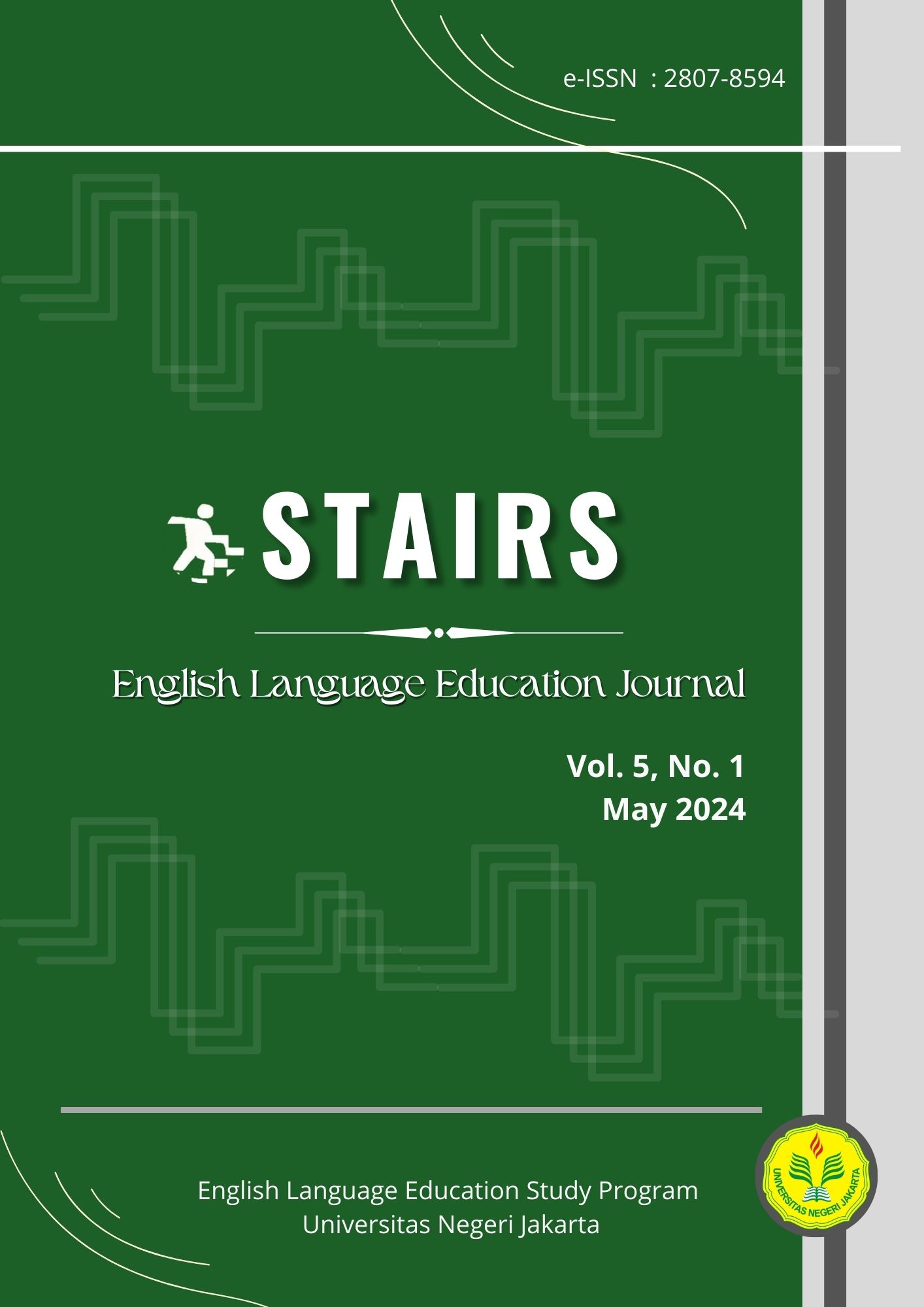Gender Representation in The English Textbook Entitled “Stop Bullying Now” for SMA/ MA/ SMK/ MAK Grade XI
Abstract
Textbook have a significant role to build students' views and
perceptions of gender. Gender representation in teaching
materials can influence the way students understand the roles of
male and female in society. This research aims to analyze gender
representation in textbook using a quantitative approach and the
gender representation grid developed by Brugeilles and Cromer
(2009). The findings reveal a significant dominance of male
characters in the representation within the textbook. The number
of male characters presented is considerably higher than that of
female characters. Moreover, male characters tend to be
assigned roles that align with gender stereotypes prevailing in
patriarchal societies. This indicates an imbalance in gender
representation within the textbook. These findings carry
significant implications for creating inclusive and diverse
learning materials to ensure they reflect gender equality and
diversity within society. By understanding and recognizing this
imbalance, it is hoped that content developers will be motivated
to produce more representative and gender-sensitive materials.
References
Acar-Erdol, T., & Gözütok, F. D. (2018). Development of gender equality curriculum and its reflective assessment. Turkish Journal of Education, 7(3), 117-135.
Azisah, S. (2017). Gender Representation in English Textbooks of 2013 Curriculum in an Islamic Junior High School in South Sulawesi Indonesia. In Proceeding: International Conference on Natural and Social Sciences.
Campbell, D. T., & Stanley, J. C. (2015). Experimental and quasi-experimental designs for research. Ravenio books.
Coleman, K. (2017). Sociology 200: Introduction to Women’s Studies. Santa Clarita, California.
Curaming, E. M., & Curaming, R. A. (2020). Gender (in) equality in English textbooks in the Philippines: a critical discourse analysis. Sexuality & Culture, 24, 1167-1188.
Gailea, N., & Mulyana, A. (2020). Gender Equality in Online English Book in Reading and Writing Materials. ELTR Journal, 4(1), 76-90.
Hornbæk, K., & Oulasvirta, A. (2017, May). What is interaction? In Proceedings of the 2017 CHI Conference on Human Factors in Computing Systems (pp. 5040-5052).
Hsieh, H. F., & Shannon, S. E. (2005). Three approaches to qualitative content analysis. Qualitative health research, 15(9), 1277-1288.
Hutaluju, J. P. (2015). Analisis peran perempuan dalam pertanian Di kecamatan rasau jaya kabupaten kuburaya. Journal Social Economics of Agriculture, 4(1), 83-90.
Islam, K. M. M., & Asadullah, M. N. (2018). Gender stereotypes and education: A comparative content analysis of Malaysian, Indonesian, Pakistani and Bangladeshi school textbooks. PloS one, 13(1), e0190807.
Lee, H., & Pollitzer, E. (2016). Gender in science and innovation as a component of inclusive socioeconomic growth. Portia Limited.
Lee, J. F., & Chin, A. C. (2019). Are females and males equitably represented? A study of early readers. Linguistics and Education, 49, 52-61.
Leung, L. (2015). Validity, reliability, and generalizability in qualitative research. Journal of family medicine and primary care, 4(3), 324.
McCauley, A., & Ruggeri, A. (2018). Formulating Research Questions & Designing Research Projects in International Relations1.
Ministry of Education and Culture Indonesia. (2016). The Management of National Education in 2014/2015 at a Glance.
National Science Board. (2020). The state of U.S. Science and Engineering. https://ncses.nsf.gov/pubs/nsb20201
National Science Foundation, National Center for Science and Engineering Statistics. (2017).
Puspitawati, H. (2013). Konsep, teori dan analisis gender. Bogor: Departe-men Ilmu Keluarga dan Kon-sumen Fakultas Ekologi Manusia Institut Pertanian.
Rachmijati, C., & Cahyati, S. S. (2018). Gender Representation in Textbook Bahasa Inggris Grade X. Eltin Journal, Journal of English Language Teaching in Indonesia, 6(2), 59-69.
Rohmatillah, R. (2015). Readability Level of Reading Texts in the English Textbook Entitled English Alive for Senior High School Grade X Published by Yudhistira. English Education: Jurnal Tadris Bahasa Inggris, 7(1), 81-101.
Rowley-Jolivet, E. (2017). English as a Lingua Franca in research articles: the SciELF corpus. ASp. la revue du GERAS, (71), 145-158.
Sadker, D., Earley, K. Z. P., McCormick, T., Strawn, C., & Preston, J. (2014). The treatment of gender equity in teacher education. In Handbook for achieving gender equity through Education (pp. 161-180). Routledge.
Sadker, D., Earley, K. Z. P., McCormick, T., Strawn, C., & Preston, J. (2014). The treatment of gender equity in teacher education. In Handbook for achieving gender equity through Education (pp.161-180). Routledge.
Shastri, A. (2014). Gender inequality and women discrimination. IOSR Journal of Humanities and social science, 19(11), 27-30.
Shorten, A., & Moorley, C. (2014). Selecting the sample. Evidence-based nursing, 17(2), 32-33.
Smith, M. J., & Payne, E. (2016, January). Binaries and biology: Conversations with elementary education professionals after professional development on supporting transgender students. In The Educational Forum (Vol. 80, No. 1, pp. 34-47). Routledge.
Tigunova, A., Yates, A., Mirza, P., & Weikum, G. (2019). Listening between the lines: Learning personal attributes from conversations. In The World Wide Web Conference (pp. 1818-1828).
Tindall, N. T., & Waters, R. D. (2017). Does Gender and Professional Experience Influence Students’ Wahyuningsih, S., Fitri, S., & Komalasari, G. (2014). Gaya Kepemimpinan Perempuan




